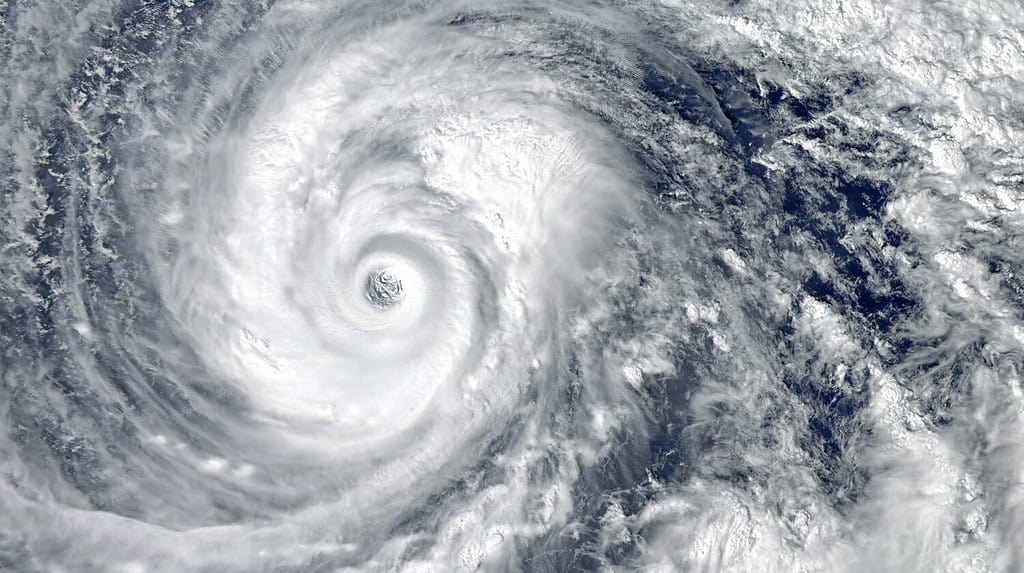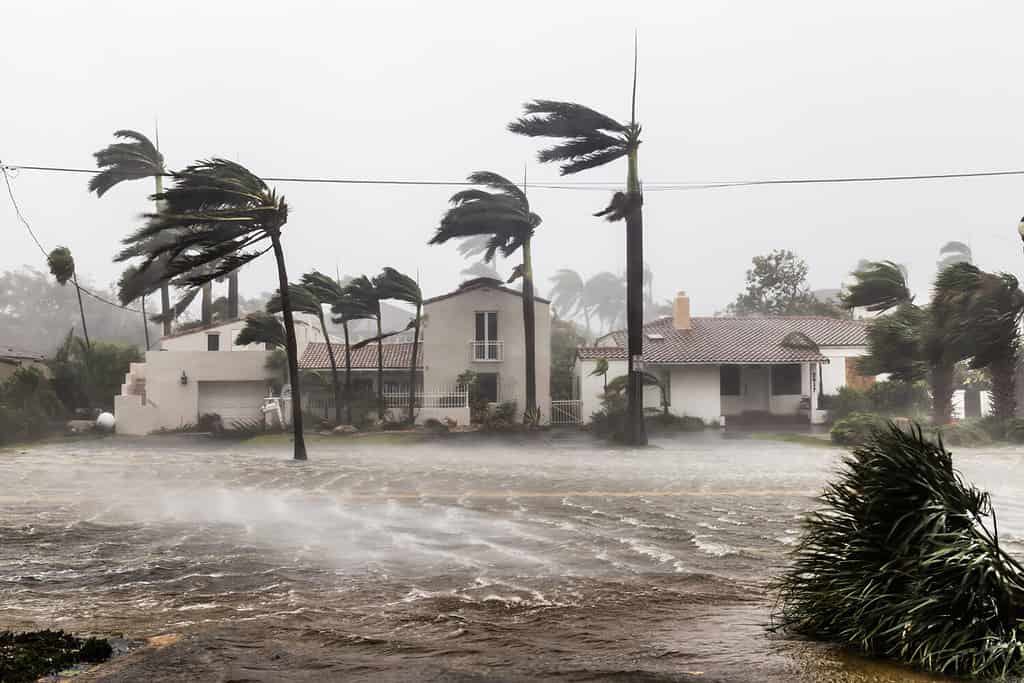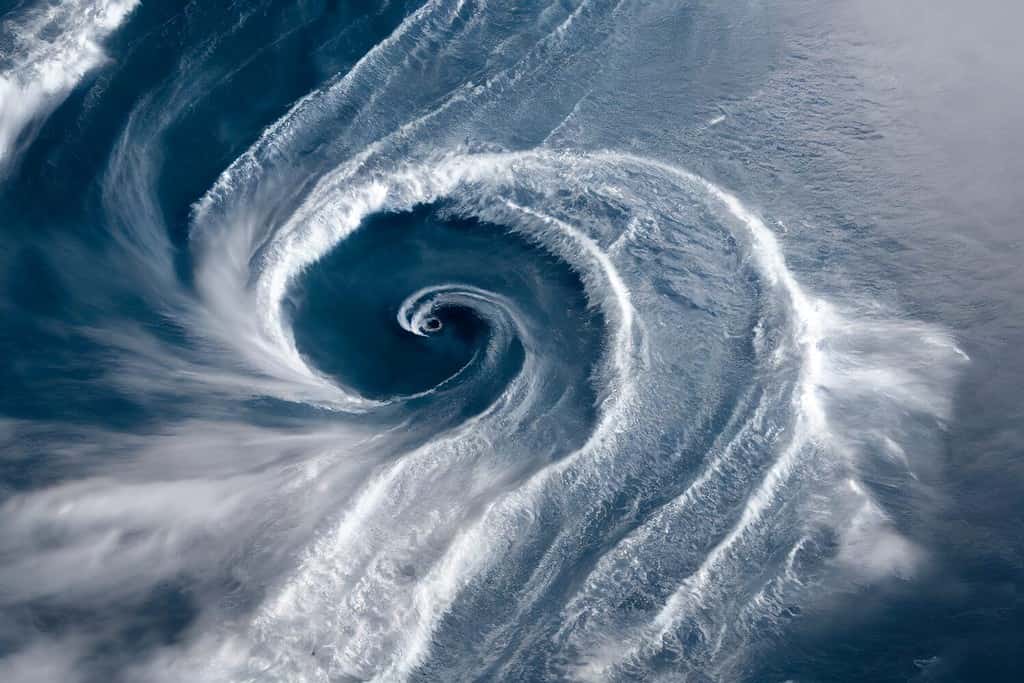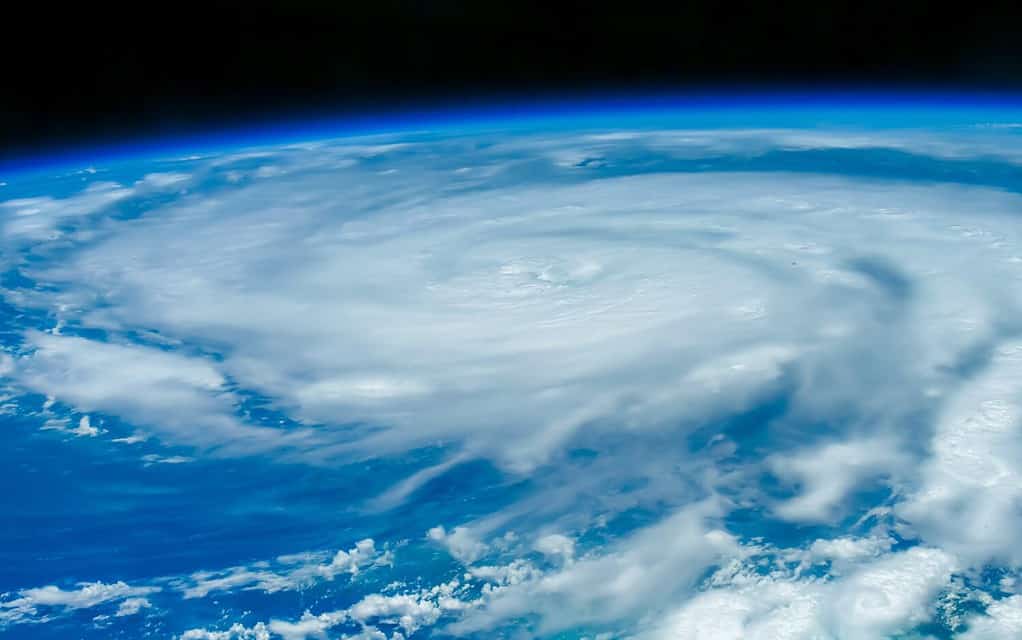Mississippi is no stranger to the devastating impact of hurricanes. Over the years, the state has experienced numerous powerful storms, but one stands out as the most formidable: Hurricane Camille.
Hurricane Season in Mississippi
Hurricane season in Mississippi officially spans six months, beginning on June 1 and ending on November 30. However, the peak of hurricane activity typically occurs from August to October. During this period, the conditions in the Atlantic Ocean and Gulf of Mexico are most favorable for the development and intensification of tropical cyclones. It is during these months that residents and authorities remain on high alert for the potential impact of hurricanes.

Hurricane Camille was a Category 5 hurricane. Pictured is a satellite view of the eye of a Category 5. Credit: NASA
©Evgeniyqw/Shutterstock.com
Mississippi, along with other Gulf Coast states, experiences hurricanes on a fairly regular basis. However, the frequency and severity of hurricanes can vary from year to year. The track of hurricanes is influenced by various atmospheric and oceanic conditions. This makes it challenging to predict exactly where a hurricane will make landfall. While the entire Mississippi coastline is susceptible to hurricane impacts, historical data indicates that the central and eastern portions of the coastline are more prone to direct hits.
Over the years, Mississippi has faced its fair share of devastating hurricanes. One notable example is Hurricane Katrina, which made landfall on August 29, 2005, as a Category 3 hurricane. The storm surge caused by Katrina was responsible for catastrophic damage along the Mississippi Gulf Coast. It resulted in the loss of lives and widespread destruction of homes, infrastructure, and natural habitats. This tragic event was a wake-up call and lead to significant improvements in hurricane preparedness and response efforts.

When it made landfall in 2005 as a Category 3, the damage Hurricane Katrina caused was immense.
©LiL SUS/Shutterstock.com
The Most Powerful Hurricane in Mississippi
The most powerful hurricane to make landfall in Mississippi is Hurricane Camille. This catastrophic storm struck the Gulf Coast on August 17, 1969, leaving a lasting impact on the state.
Hurricane Camille made landfall along the Mississippi Gulf Coast, specifically near Bay St. Louis and Pass Christian. The storm quickly intensified as it approached the coast, reaching a Category 5 hurricane on the Saffir-Simpson Hurricane Wind Scale. This is the highest category reserved for the most intense hurricanes. It is important to note that hurricane categorization is based on wind speeds, but the destructive potential of a hurricane extends beyond wind to include storm surge, rainfall, and other factors.
Wind Speeds and Impact of Hurricane Camille
Hurricane Camille unleashed its devastating power with sustained winds of around 175 mph and wind gusts exceeding 200 mph near the eye of the storm. The incredible force of the hurricane resulted in the destruction of numerous structures, uprooted trees, and caused widespread power outages. The storm surge generated by Hurricane Camille reached an astounding 24 feet in some areas, leading to significant coastal flooding and further exacerbating the damage.

Hurricane Irma was a Category 5 hurricane that struck Fort Lauderdale, FL, in 2017. Only a fraction of the damage it caused is visible here.
©FotoKina/Shutterstock.com
Wildlife Can Be Impacted by Hurricanes
The impact of hurricanes extends beyond human structures and communities; they also affect the diverse wildlife that inhabits the Mississippi region.
Impacts on Birds
The coastal areas of Mississippi serve as crucial habitats for a wide variety of bird species. During hurricanes, these birds face significant challenges, including strong winds, flooding, and habitat destruction. However, many bird species have evolved adaptations to navigate and survive these extreme weather events. Some birds, such as shorebirds and seabirds, can sense the approaching storms and take evasive action by flying to safer locations or hunkering down in protected areas until the storm passes. Many bird species are resilient and can rebuild their populations after the passage of a hurricane.
Birds That May Be Affected by Hurricanes
- Reddish Egret: The reddish egret, a wading bird found in coastal areas of Mississippi, relies on shallow marshes and estuaries for foraging. During hurricanes, these habitats can be severely affected by storm surges and flooding, leading to a disruption in the availability of prey and potential habitat loss.
- Least Tern: The least tern is a small migratory bird that nests along the beaches and barrier islands of Mississippi’s coast. Hurricanes can cause the destruction of nesting sites, including the loss of eggs and chicks due to flooding, high winds, and erosion.
- Black Skimmer: Similar to the least tern, the black skimmer nests on coastal beaches and islands. Their ground-level nests are particularly vulnerable to storm surges and high tides associated with hurricanes, which can wash away eggs and destabilize nesting sites.
- Clapper Rail: The clapper rail, a secretive marsh bird, inhabits coastal saltmarshes and wetlands. Hurricanes can submerge their preferred habitat, making foraging and nesting difficult. The destruction of marsh vegetation can also affect their camouflage and expose them to increased predation risks.
- Painted Bunting: The painted bunting, a brightly colored songbird, migrates through Mississippi during spring and fall. Hurricanes can disrupt their migration patterns and disrupt food availability, as the storms may destroy or alter habitats and food sources along their migratory routes.

Hurricanes frequently cause tornadoes and can bring over 6 feet of rain.
©Vikks/Shutterstock.com
Impacts on fish and aquatic life
Mississippi’s coastal waters are home to a rich diversity of fish species, including redfish, speckled trout, flounder, and shrimp. Hurricanes can disrupt the delicate balance of coastal ecosystems by causing changes in water salinity, temperature, and oxygen levels. The storm surge associated with hurricanes can also result in the intrusion of saltwater into freshwater habitats and vice versa, affecting the survival of various fish species. However, some fish species, like redfish and speckled trout, have adaptations that allow them to seek refuge in deeper waters or move to more suitable habitats, ensuring their survival during and after hurricanes.
Aquatic life that may be affected by hurricanes
- Gulf Sturgeon: The Gulf sturgeon is a large, migratory fish found in the Mississippi River and its tributaries. Hurricanes can lead to increased water flow and changes in salinity levels in the river, which affects the spawning and migration patterns of these fish. Flooding can also cause sedimentation, which impacts the way these fish feed.
- Speckled Trout: Speckled trout, also known as spotted seatrout or specks, are popular game fish found in Mississippi’s coastal waters. Hurricanes can cause changes in water temperature, salinity, and oxygen levels, affecting the availability of suitable habitats and food sources for these fish. Furthermore, storm surges can result in the displacement of speckled trout populations.
- Red Drum: Also called redfish or channel bass, these fish inhabit Mississippi’s estuaries, bays, and coastal waters. Like speckled trout, red drum can be impacted by hurricanes due to changes in water quality, temperature, and salinity. Habitat degradation and displacement can occur, affecting their feeding and spawning behaviors.
- Blue Crab: Blue crab is an important commercial and recreational species in Mississippi’s coastal areas. Hurricanes can disrupt their habitats, including salt marshes and estuaries, through storm surges, sedimentation, and increased freshwater inflow. These changes can impact the availability of food and shelter for blue crabs, potentially affecting their populations.
- Diamondback Terrapin: The diamondback terrapin is a water turtle species found in Mississippi’s coastal marshes and estuaries. Hurricanes can cause habitat destruction, flooding, and changes in water salinity, impacting the availability of suitable nesting areas and food sources for these turtles. The loss of nesting sites due to erosion can also have long-term effects on their reproductive success.

Hurricane Ida, a Category 4, is the second-most damaging hurricane to strike Louisiana, after Hurricane Katrina.
©Emre Akkoyun/Shutterstock.com
Impacts on Terrestrial Animals
Terrestrial animals in Mississippi, including mammals, reptiles, and insects, face significant challenges during hurricanes. The destruction of habitats, loss of food sources, and displacement caused by flooding can have profound effects on these species. However, many animals have developed adaptations to mitigate the impacts of hurricanes. For instance, mammals like deer and raccoons can seek higher ground or take shelter in dens and burrows. Reptiles, such as alligators and snakes, are adept at finding refuge in water bodies or using their natural camouflage to protect themselves. Insects may seek shelter underground or in dense vegetation to survive the storm’s passage.
Animals That May Be Affected by Hurricanes
- White-Tailed Deer: White-tailed deer are common throughout Mississippi’s forests and woodlands. Hurricanes can cause the loss of forest cover and destruction of vegetation, disrupting the deer’s habitat and food sources. Additionally, severe storms can lead to flooding, making it difficult for deer to find suitable shelter and increasing their vulnerability to predation.
- Eastern Box Turtle: Eastern box turtles are terrestrial reptiles found in Mississippi’s forests, fields, and wetlands. Hurricanes can damage their habitat, including fallen trees and debris, which can pose a threat to these slow-moving turtles. Flooding can also limit their movement and lead to death in young turtles.
- American Black Bear: American black bears inhabit forested regions of Mississippi. Hurricanes can impact their habitat by causing tree damage, destruction of dens, and disruption of food sources such as acorns and berries. Bears may also face challenges in finding suitable shelter during severe storms.
- Eastern Cottontail Rabbit: Eastern cottontail rabbits are common in Mississippi’s grasslands and forest edges. Hurricanes can destroy their habitat, including vegetation cover and protective burrows. The loss of food sources and increased predation risks during and after storms can impact the population of these rabbits.
- Eastern Diamondback Rattlesnake: The eastern diamondback rattlesnake is a venomous snake found in Mississippi’s coastal plain and pine savannas. Hurricanes can flood their burrows, disrupt their natural habitat, and impact their ability to find suitable prey. The destruction of vegetation cover can also expose them to increased predation risks.

In 2005, Hurricane Katrina decimated and devastated so much of New Orleans.
©Marc Pagani Photography/Shutterstock.com
Hurricane Preparedness and Response
Given the recurring nature of hurricanes, preparedness is of utmost importance for Mississippi residents. The state and local authorities have robust hurricane preparedness plans in place, which include early warning systems, evacuation protocols, and coordination with emergency response agencies. Residents are encouraged to create emergency kits, develop evacuation plans, secure their properties, and stay informed through reliable sources of weather information.
The wildlife of Mississippi can be protected from the impacts of hurricanes in several ways. Organizations and governments can restore natural habitats after hurricanes, which are crucial for providing animals with a better chance of surviving and recovering after a storm. Raising awareness among the public about the importance of wildlife and their habitats is also essential. People can also establish monitoring systems to track wildlife populations and their habitats can provide valuable data before, during, and after a hurricane, and give us a better sense of how to prevent complete habitat destruction of these precious animals.
The photo featured at the top of this post is © Triff/Shutterstock.com
Thank you for reading! Have some feedback for us? Contact the AZ Animals editorial team.






